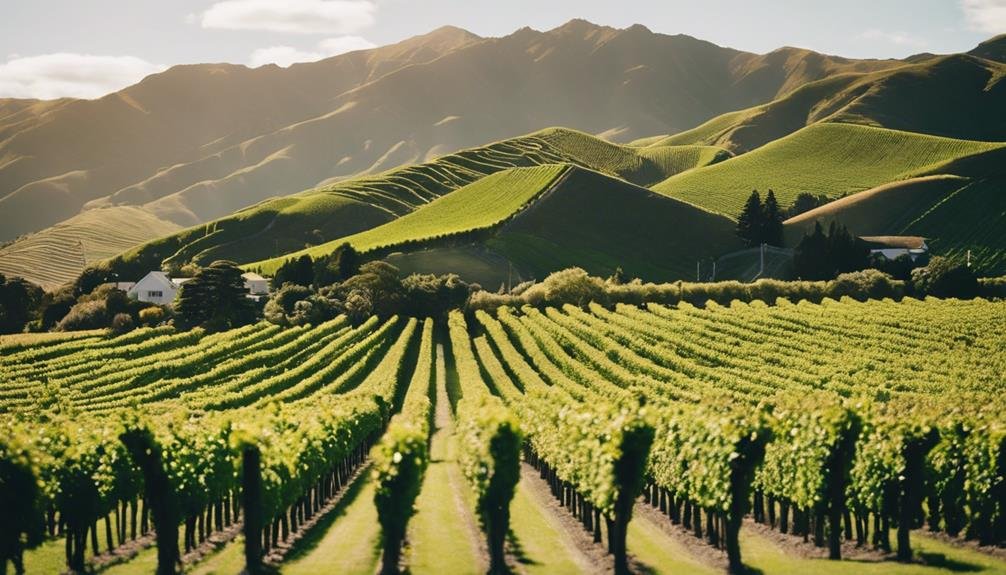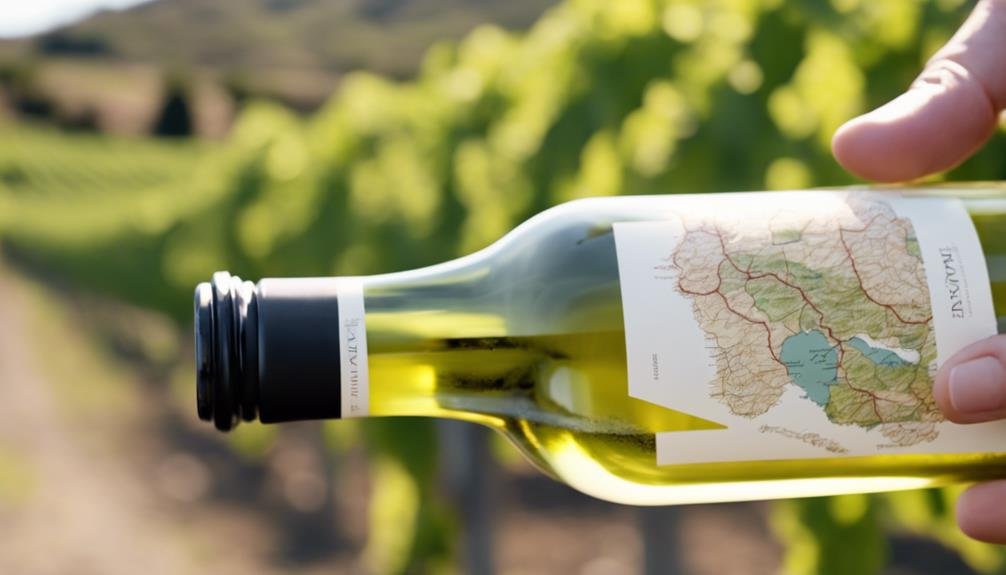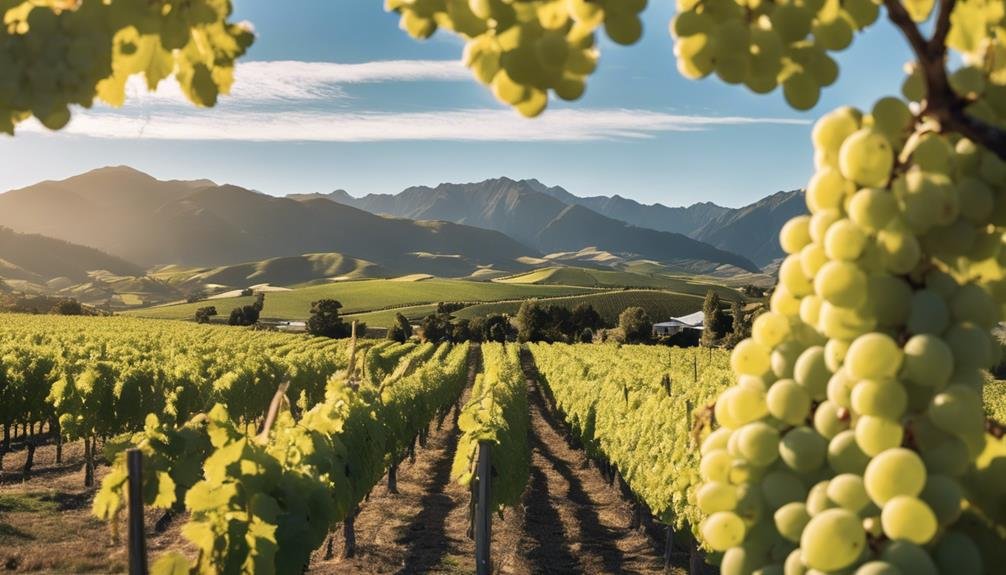Discover the varied terroirs of New Zealand Sauvignon Blanc. Marlborough reigns as the pinnacle, shaping global standards with its stony soils and vibrant tropical fruits. The North Island boasts ripe, fruity styles rich in stone fruit, while the South Island captivates with pungent acidity and tropical notes. Each region, like Hawkes Bay and Central Otago, offers distinct flavors influenced by unique climates and winemaking techniques. Consider pairing with seafood for an exquisite experience. Explore the intricate nuances of New Zealand's Sauvignon Blanc regions, where diverse flavors await discovery.
New Zealand Sauvignon Blanc Overview
New Zealand's Sauvignon Blanc wines are globally renowned for their distinctive herbaceous-yet-floral aroma and vibrant citrus flavors, making them a hallmark of the country's winemaking excellence.
The flavor profiles of these wines typically include primary fruit flavors like lime, gooseberry, grapefruit, passion fruit, and mango, alongside herbal notes such as lemongrass, fresh-cut grass, and bell pepper. High acidity gives a invigorating and mouth-puckering sensation, making them perfect for pairing with a variety of foods.
When it comes to aging potential, most New Zealand Sauvignon Blancs are best enjoyed within 1-3 years of release. For serving temperatures, it is recommended to serve these wines chilled, around 45-50°F (7-10°C), to fully appreciate their vibrant flavors and aromas.
Marlborough: The King of Sauvignon Blanc
Renowned for its unparalleled influence on the global Sauvignon Blanc market, Marlborough stands as the unrivaled monarch of this distinctive wine varietal.
The vineyard terroir in Marlborough, characterized by stony soils and a maritime climate, imparts unique flavors to the Sauvignon Blanc grapes grown here.
Winemaking techniques in Marlborough focus on preserving the vibrant fruit characteristics and crisp acidity that define the region's signature style.
With a reputation for producing Sauvignon Blancs with intense tropical fruit notes and herbaceous undertones, Marlborough has set the standard for this varietal worldwide.
The careful balance between vineyard practices and winemaking expertise has solidified Marlborough's position as the King of Sauvignon Blanc.
North Island Vs. South Island Contrasts

In the world of New Zealand Sauvignon Blanc, the distinct contrasts between the North Island and the South Island play a significant role in shaping the diverse expressions of this renowned wine varietal.
Climate differences between the two islands result in unique flavor profiles. The North Island tends to offer riper, fruity styles with flavors like stone fruit and nectarine, while the South Island produces pungent, acidic Sauvignon Blancs with vibrant tropical fruits.
These differences are further influenced by regional terroir and winemaking techniques. Understanding these distinctions can help enthusiasts appreciate the variety and complexity that New Zealand Sauvignon Blanc has to offer, showcasing the impact of geographical elements on the final product.
Exploring Unique Regional Characteristics
Exploring the distinctive terroir-driven nuances of various regions enriches the understanding of New Zealand Sauvignon Blanc's diverse expressions. Different regions in New Zealand impart unique characteristics to the Sauvignon Blanc through their specific flavor profiles, influenced by terroir, climate impact, and winemaking techniques. Below is a table highlighting some key differences among prominent New Zealand regions:
| Region | Flavor Profiles |
|---|---|
| Marlborough | Intense tropical fruits and herbs |
| Hawkes Bay | Ripe stone fruits and nectarine |
| Wairarapa | Elegant citrus and mineral notes |
| Gisborne | Rich passion fruit and guava |
| Central Otago | Crisp acidity with floral undertones |
Each region's unique terroir and climate contribute to the diverse expressions found in New Zealand Sauvignon Blanc, making it a fascinating wine to explore.
Tips for Discovering Exceptional Bottles

When seeking out exceptional bottles of New Zealand Sauvignon Blanc, understanding key factors such as vintage quality and price points can greatly enhance your tasting experience. Here are some tips to help you discover outstanding bottles:
- Food Pairings and Tasting Notes: Pair your New Zealand Sauvignon Blanc with dishes like grilled asparagus, goat cheese salads, or seafood to complement its herbaceous and citrusy flavors.
- Aging Potential and Serving Temperature: While most NZ Sauvignon Blanc is best enjoyed young, some high-quality bottles from exceptional vintages can age well for a few years. Serve at a cool temperature, around 45-50°F (7-10°C), to fully appreciate its vibrant acidity and fruit-forward profile.
Frequently Asked Questions
Can New Zealand Sauvignon Blanc Age Well Beyond 3 Years?
New Zealand Sauvignon Blanc typically doesn't age well beyond 3 years due to its vibrant acidity and fresh fruit flavors. Cellaring tips include selecting high-quality vintages like 2016, 2015, or 2010. Tasting notes reveal zesty citrus and herbaceous aromas.
What Food Pairings Complement New Zealand Sauvignon Blanc Best?
When exploring wine pairings, New Zealand Sauvignon Blanc harmonizes beautifully with summer dishes, especially seafood. Its vibrant flavors of citrus, tropical fruits, and herbs complement the freshness of seafood, enhancing the dining experience.
Are There Organic or Biodynamic New Zealand Sauvignon Blanc Options?
Organic and biodynamic New Zealand Sauvignon Blanc options showcase sustainable viticulture practices. These vineyards prioritize soil health, biodiversity, and natural pest control. By embracing eco-friendly methods, these wines offer a harmonious blend of environmental consciousness and exceptional quality.
How Does Climate Change Impact New Zealand Sauvignon Blanc Production?
Climate change impacts New Zealand Sauvignon Blanc production through altering vineyard management practices for sustainability. Grape varietals are adapting to changing conditions. Vineyards are implementing strategies to mitigate effects while maintaining quality and unique characteristics of the wine.
Can New Zealand Sauvignon Blanc Be Used in Cocktails or Cooking?
New Zealand Sauvignon Blanc can enhance cocktail creations and elevate culinary experiments. With its herbaceous and citrusy profile, this versatile wine adds a vibrant dimension to mixed drinks and dishes, offering a unique and invigorating twist.
Conclusion
To sum up, New Zealand Sauvignon Blanc offers a diverse range of flavors and characteristics that are influenced by the unique regions where they are produced.
One interesting statistic is that Marlborough, the largest wine-growing region in New Zealand, accounts for over 75% of the country's total wine production.
By exploring the distinct qualities of each region, wine enthusiasts can truly appreciate the complexity and richness of New Zealand Sauvignon Blanc.
